Analysis of Therapeutic Models and Counselling Session Activities
VerifiedAdded on 2020/06/05
|18
|6280
|421
Report
AI Summary
This report provides a comprehensive overview of therapeutic models and counselling activities, encompassing various aspects of the counselling process. Part A delves into the stages of counselling sessions, emphasizing the importance of a suitable environment, appropriate openings, and working agreements. It explores skills and interventions, and the ending of a series of sessions. Part B focuses on the philosophy of therapeutic models, their key concepts, strengths, weaknesses, and arguments against them. It also highlights the relevance of these models for practicing counsellors. Part C addresses theories that increase awareness, including their application and relationships to development, client interaction, and the impact of equity and diversity. Part D evaluates the relevance of cultural divisions and heritage within the counselling process, and how these factors influence counsellor-client interactions. The report incorporates research methodologies, learning outcomes, and areas for professional development, all of which are critical for effective and ethical counselling practice.
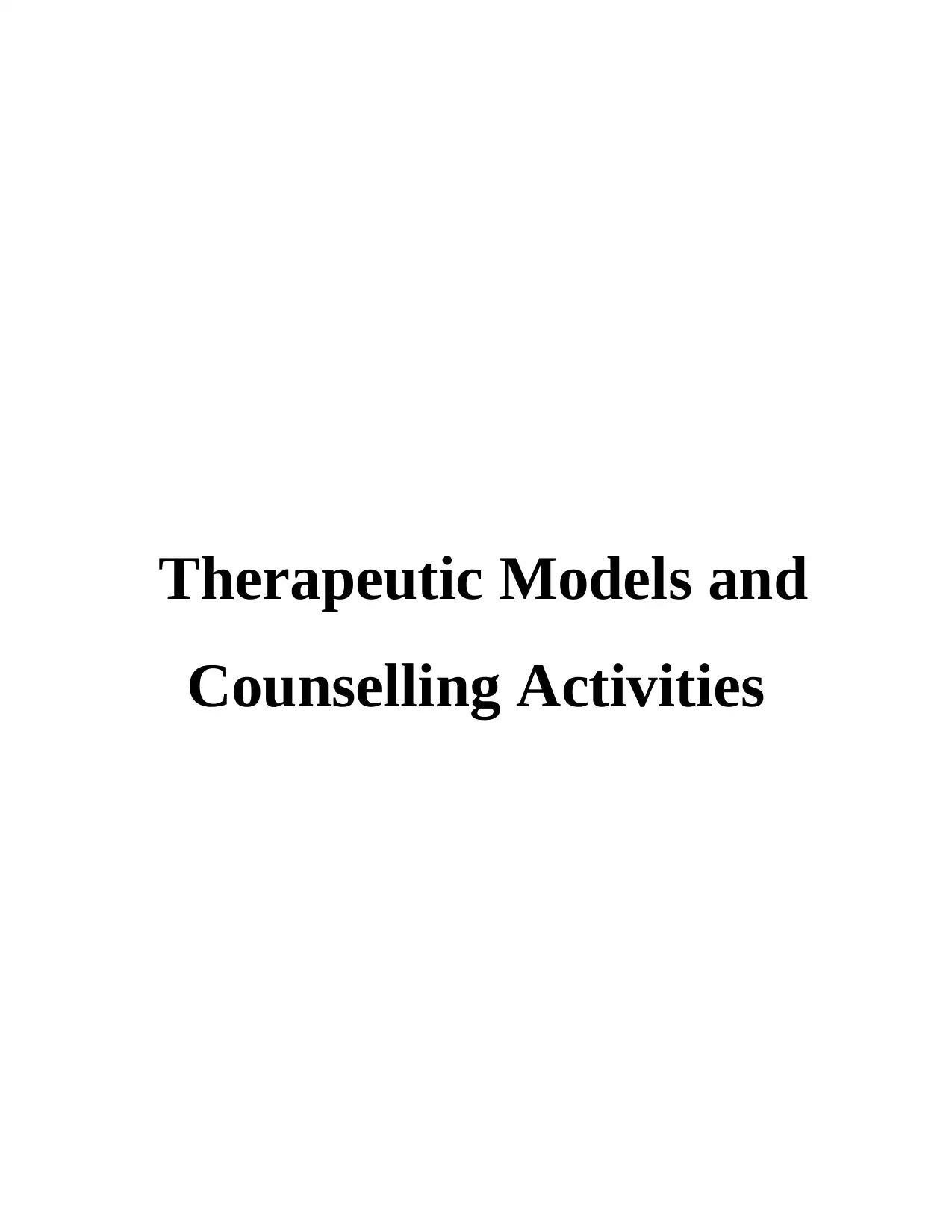
Therapeutic Models and
Counselling Activities
Counselling Activities
Paraphrase This Document
Need a fresh take? Get an instant paraphrase of this document with our AI Paraphraser
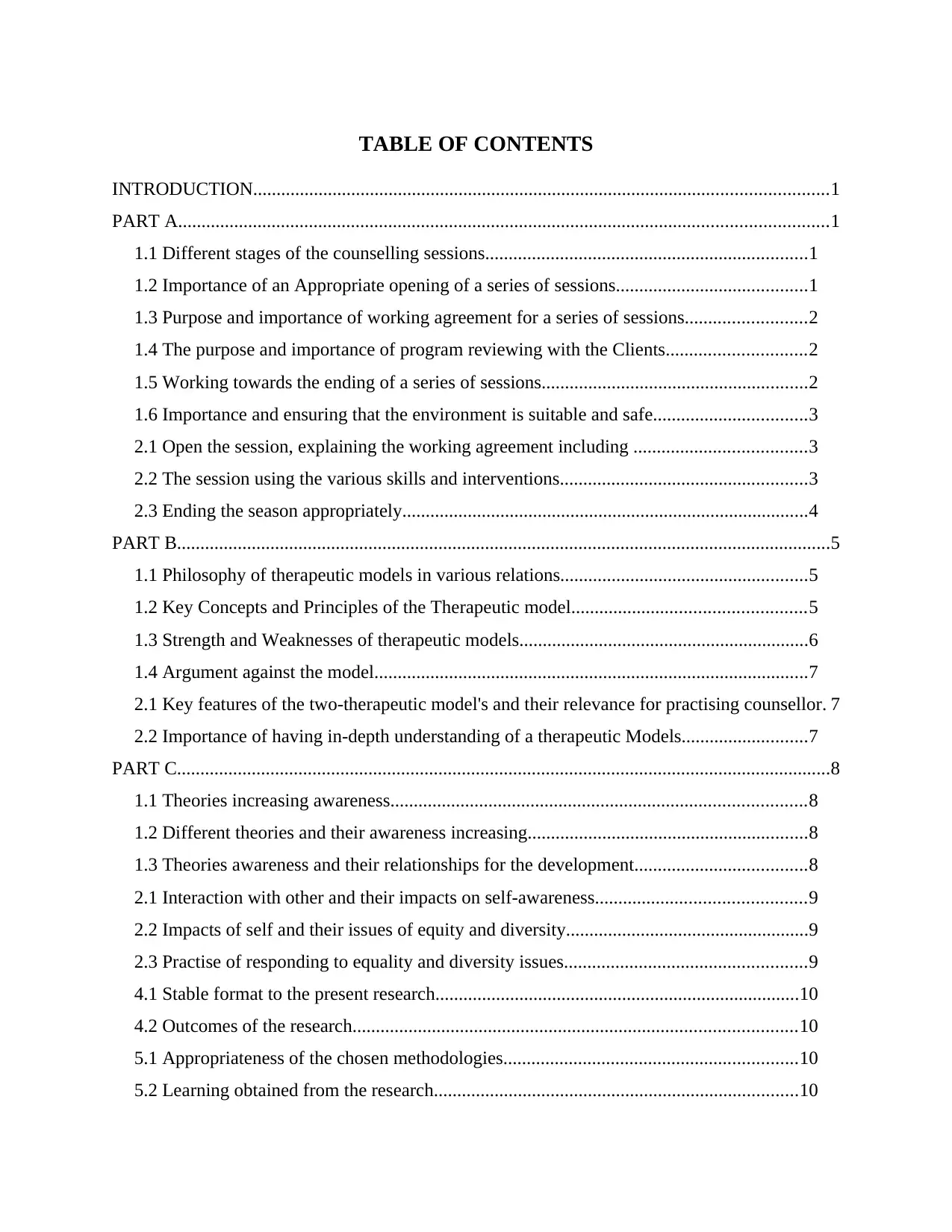
TABLE OF CONTENTS
INTRODUCTION...........................................................................................................................1
PART A...........................................................................................................................................1
1.1 Different stages of the counselling sessions.....................................................................1
1.2 Importance of an Appropriate opening of a series of sessions.........................................1
1.3 Purpose and importance of working agreement for a series of sessions..........................2
1.4 The purpose and importance of program reviewing with the Clients..............................2
1.5 Working towards the ending of a series of sessions.........................................................2
1.6 Importance and ensuring that the environment is suitable and safe.................................3
2.1 Open the session, explaining the working agreement including .....................................3
2.2 The session using the various skills and interventions.....................................................3
2.3 Ending the season appropriately.......................................................................................4
PART B............................................................................................................................................5
1.1 Philosophy of therapeutic models in various relations.....................................................5
1.2 Key Concepts and Principles of the Therapeutic model..................................................5
1.3 Strength and Weaknesses of therapeutic models..............................................................6
1.4 Argument against the model.............................................................................................7
2.1 Key features of the two-therapeutic model's and their relevance for practising counsellor. 7
2.2 Importance of having in-depth understanding of a therapeutic Models...........................7
PART C............................................................................................................................................8
1.1 Theories increasing awareness.........................................................................................8
1.2 Different theories and their awareness increasing............................................................8
1.3 Theories awareness and their relationships for the development.....................................8
2.1 Interaction with other and their impacts on self-awareness.............................................9
2.2 Impacts of self and their issues of equity and diversity....................................................9
2.3 Practise of responding to equality and diversity issues....................................................9
4.1 Stable format to the present research..............................................................................10
4.2 Outcomes of the research...............................................................................................10
5.1 Appropriateness of the chosen methodologies...............................................................10
5.2 Learning obtained from the research..............................................................................10
INTRODUCTION...........................................................................................................................1
PART A...........................................................................................................................................1
1.1 Different stages of the counselling sessions.....................................................................1
1.2 Importance of an Appropriate opening of a series of sessions.........................................1
1.3 Purpose and importance of working agreement for a series of sessions..........................2
1.4 The purpose and importance of program reviewing with the Clients..............................2
1.5 Working towards the ending of a series of sessions.........................................................2
1.6 Importance and ensuring that the environment is suitable and safe.................................3
2.1 Open the session, explaining the working agreement including .....................................3
2.2 The session using the various skills and interventions.....................................................3
2.3 Ending the season appropriately.......................................................................................4
PART B............................................................................................................................................5
1.1 Philosophy of therapeutic models in various relations.....................................................5
1.2 Key Concepts and Principles of the Therapeutic model..................................................5
1.3 Strength and Weaknesses of therapeutic models..............................................................6
1.4 Argument against the model.............................................................................................7
2.1 Key features of the two-therapeutic model's and their relevance for practising counsellor. 7
2.2 Importance of having in-depth understanding of a therapeutic Models...........................7
PART C............................................................................................................................................8
1.1 Theories increasing awareness.........................................................................................8
1.2 Different theories and their awareness increasing............................................................8
1.3 Theories awareness and their relationships for the development.....................................8
2.1 Interaction with other and their impacts on self-awareness.............................................9
2.2 Impacts of self and their issues of equity and diversity....................................................9
2.3 Practise of responding to equality and diversity issues....................................................9
4.1 Stable format to the present research..............................................................................10
4.2 Outcomes of the research...............................................................................................10
5.1 Appropriateness of the chosen methodologies...............................................................10
5.2 Learning obtained from the research..............................................................................10
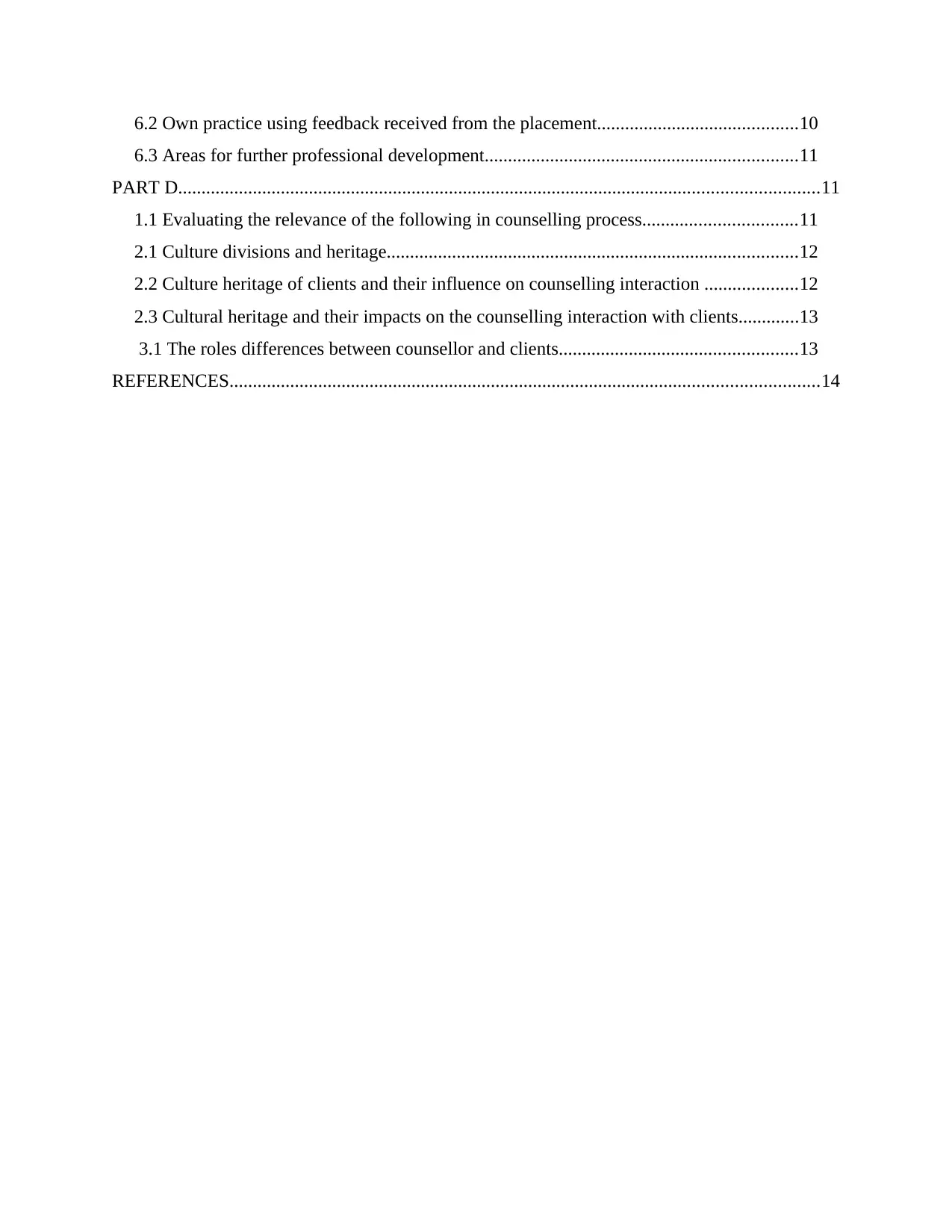
6.2 Own practice using feedback received from the placement...........................................10
6.3 Areas for further professional development...................................................................11
PART D.........................................................................................................................................11
1.1 Evaluating the relevance of the following in counselling process.................................11
2.1 Culture divisions and heritage........................................................................................12
2.2 Culture heritage of clients and their influence on counselling interaction ....................12
2.3 Cultural heritage and their impacts on the counselling interaction with clients.............13
3.1 The roles differences between counsellor and clients...................................................13
REFERENCES..............................................................................................................................14
6.3 Areas for further professional development...................................................................11
PART D.........................................................................................................................................11
1.1 Evaluating the relevance of the following in counselling process.................................11
2.1 Culture divisions and heritage........................................................................................12
2.2 Culture heritage of clients and their influence on counselling interaction ....................12
2.3 Cultural heritage and their impacts on the counselling interaction with clients.............13
3.1 The roles differences between counsellor and clients...................................................13
REFERENCES..............................................................................................................................14
⊘ This is a preview!⊘
Do you want full access?
Subscribe today to unlock all pages.

Trusted by 1+ million students worldwide
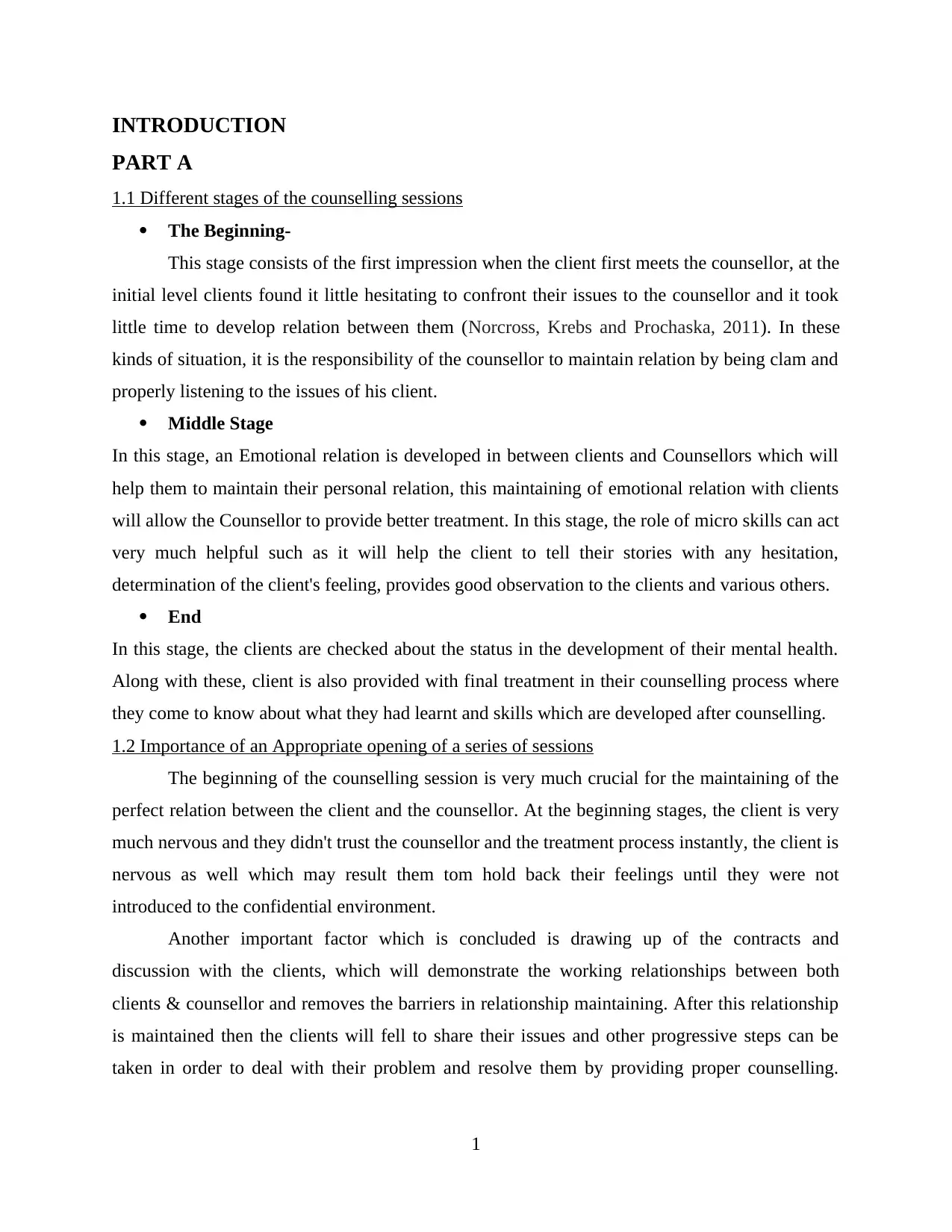
INTRODUCTION
PART A
1.1 Different stages of the counselling sessions
The Beginning-
This stage consists of the first impression when the client first meets the counsellor, at the
initial level clients found it little hesitating to confront their issues to the counsellor and it took
little time to develop relation between them (Norcross, Krebs and Prochaska, 2011). In these
kinds of situation, it is the responsibility of the counsellor to maintain relation by being clam and
properly listening to the issues of his client.
Middle Stage
In this stage, an Emotional relation is developed in between clients and Counsellors which will
help them to maintain their personal relation, this maintaining of emotional relation with clients
will allow the Counsellor to provide better treatment. In this stage, the role of micro skills can act
very much helpful such as it will help the client to tell their stories with any hesitation,
determination of the client's feeling, provides good observation to the clients and various others.
End
In this stage, the clients are checked about the status in the development of their mental health.
Along with these, client is also provided with final treatment in their counselling process where
they come to know about what they had learnt and skills which are developed after counselling.
1.2 Importance of an Appropriate opening of a series of sessions
The beginning of the counselling session is very much crucial for the maintaining of the
perfect relation between the client and the counsellor. At the beginning stages, the client is very
much nervous and they didn't trust the counsellor and the treatment process instantly, the client is
nervous as well which may result them tom hold back their feelings until they were not
introduced to the confidential environment.
Another important factor which is concluded is drawing up of the contracts and
discussion with the clients, which will demonstrate the working relationships between both
clients & counsellor and removes the barriers in relationship maintaining. After this relationship
is maintained then the clients will fell to share their issues and other progressive steps can be
taken in order to deal with their problem and resolve them by providing proper counselling.
1
PART A
1.1 Different stages of the counselling sessions
The Beginning-
This stage consists of the first impression when the client first meets the counsellor, at the
initial level clients found it little hesitating to confront their issues to the counsellor and it took
little time to develop relation between them (Norcross, Krebs and Prochaska, 2011). In these
kinds of situation, it is the responsibility of the counsellor to maintain relation by being clam and
properly listening to the issues of his client.
Middle Stage
In this stage, an Emotional relation is developed in between clients and Counsellors which will
help them to maintain their personal relation, this maintaining of emotional relation with clients
will allow the Counsellor to provide better treatment. In this stage, the role of micro skills can act
very much helpful such as it will help the client to tell their stories with any hesitation,
determination of the client's feeling, provides good observation to the clients and various others.
End
In this stage, the clients are checked about the status in the development of their mental health.
Along with these, client is also provided with final treatment in their counselling process where
they come to know about what they had learnt and skills which are developed after counselling.
1.2 Importance of an Appropriate opening of a series of sessions
The beginning of the counselling session is very much crucial for the maintaining of the
perfect relation between the client and the counsellor. At the beginning stages, the client is very
much nervous and they didn't trust the counsellor and the treatment process instantly, the client is
nervous as well which may result them tom hold back their feelings until they were not
introduced to the confidential environment.
Another important factor which is concluded is drawing up of the contracts and
discussion with the clients, which will demonstrate the working relationships between both
clients & counsellor and removes the barriers in relationship maintaining. After this relationship
is maintained then the clients will fell to share their issues and other progressive steps can be
taken in order to deal with their problem and resolve them by providing proper counselling.
1
Paraphrase This Document
Need a fresh take? Get an instant paraphrase of this document with our AI Paraphraser
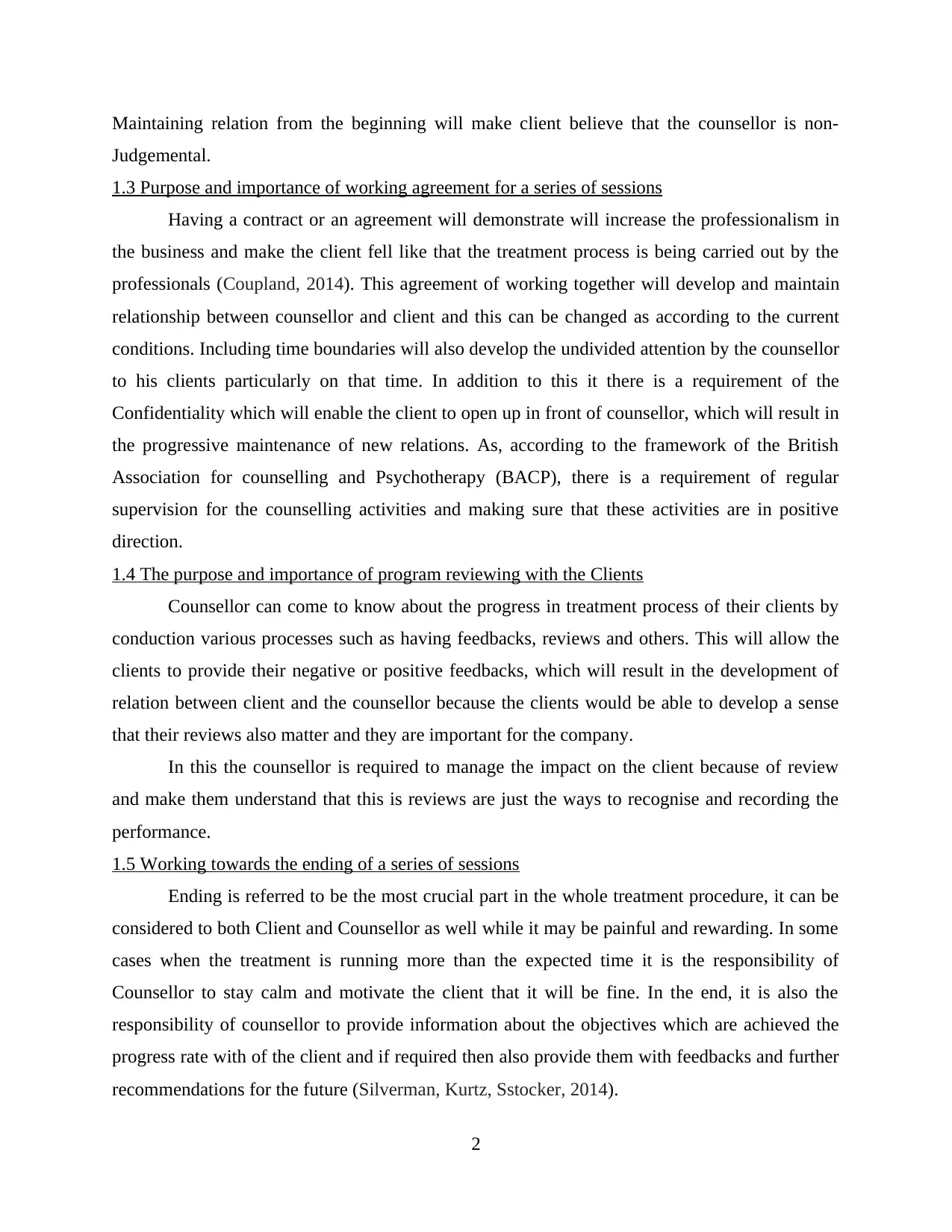
Maintaining relation from the beginning will make client believe that the counsellor is non-
Judgemental.
1.3 Purpose and importance of working agreement for a series of sessions
Having a contract or an agreement will demonstrate will increase the professionalism in
the business and make the client fell like that the treatment process is being carried out by the
professionals (Coupland, 2014). This agreement of working together will develop and maintain
relationship between counsellor and client and this can be changed as according to the current
conditions. Including time boundaries will also develop the undivided attention by the counsellor
to his clients particularly on that time. In addition to this it there is a requirement of the
Confidentiality which will enable the client to open up in front of counsellor, which will result in
the progressive maintenance of new relations. As, according to the framework of the British
Association for counselling and Psychotherapy (BACP), there is a requirement of regular
supervision for the counselling activities and making sure that these activities are in positive
direction.
1.4 The purpose and importance of program reviewing with the Clients
Counsellor can come to know about the progress in treatment process of their clients by
conduction various processes such as having feedbacks, reviews and others. This will allow the
clients to provide their negative or positive feedbacks, which will result in the development of
relation between client and the counsellor because the clients would be able to develop a sense
that their reviews also matter and they are important for the company.
In this the counsellor is required to manage the impact on the client because of review
and make them understand that this is reviews are just the ways to recognise and recording the
performance.
1.5 Working towards the ending of a series of sessions
Ending is referred to be the most crucial part in the whole treatment procedure, it can be
considered to both Client and Counsellor as well while it may be painful and rewarding. In some
cases when the treatment is running more than the expected time it is the responsibility of
Counsellor to stay calm and motivate the client that it will be fine. In the end, it is also the
responsibility of counsellor to provide information about the objectives which are achieved the
progress rate with of the client and if required then also provide them with feedbacks and further
recommendations for the future (Silverman, Kurtz, Sstocker, 2014).
2
Judgemental.
1.3 Purpose and importance of working agreement for a series of sessions
Having a contract or an agreement will demonstrate will increase the professionalism in
the business and make the client fell like that the treatment process is being carried out by the
professionals (Coupland, 2014). This agreement of working together will develop and maintain
relationship between counsellor and client and this can be changed as according to the current
conditions. Including time boundaries will also develop the undivided attention by the counsellor
to his clients particularly on that time. In addition to this it there is a requirement of the
Confidentiality which will enable the client to open up in front of counsellor, which will result in
the progressive maintenance of new relations. As, according to the framework of the British
Association for counselling and Psychotherapy (BACP), there is a requirement of regular
supervision for the counselling activities and making sure that these activities are in positive
direction.
1.4 The purpose and importance of program reviewing with the Clients
Counsellor can come to know about the progress in treatment process of their clients by
conduction various processes such as having feedbacks, reviews and others. This will allow the
clients to provide their negative or positive feedbacks, which will result in the development of
relation between client and the counsellor because the clients would be able to develop a sense
that their reviews also matter and they are important for the company.
In this the counsellor is required to manage the impact on the client because of review
and make them understand that this is reviews are just the ways to recognise and recording the
performance.
1.5 Working towards the ending of a series of sessions
Ending is referred to be the most crucial part in the whole treatment procedure, it can be
considered to both Client and Counsellor as well while it may be painful and rewarding. In some
cases when the treatment is running more than the expected time it is the responsibility of
Counsellor to stay calm and motivate the client that it will be fine. In the end, it is also the
responsibility of counsellor to provide information about the objectives which are achieved the
progress rate with of the client and if required then also provide them with feedbacks and further
recommendations for the future (Silverman, Kurtz, Sstocker, 2014).
2
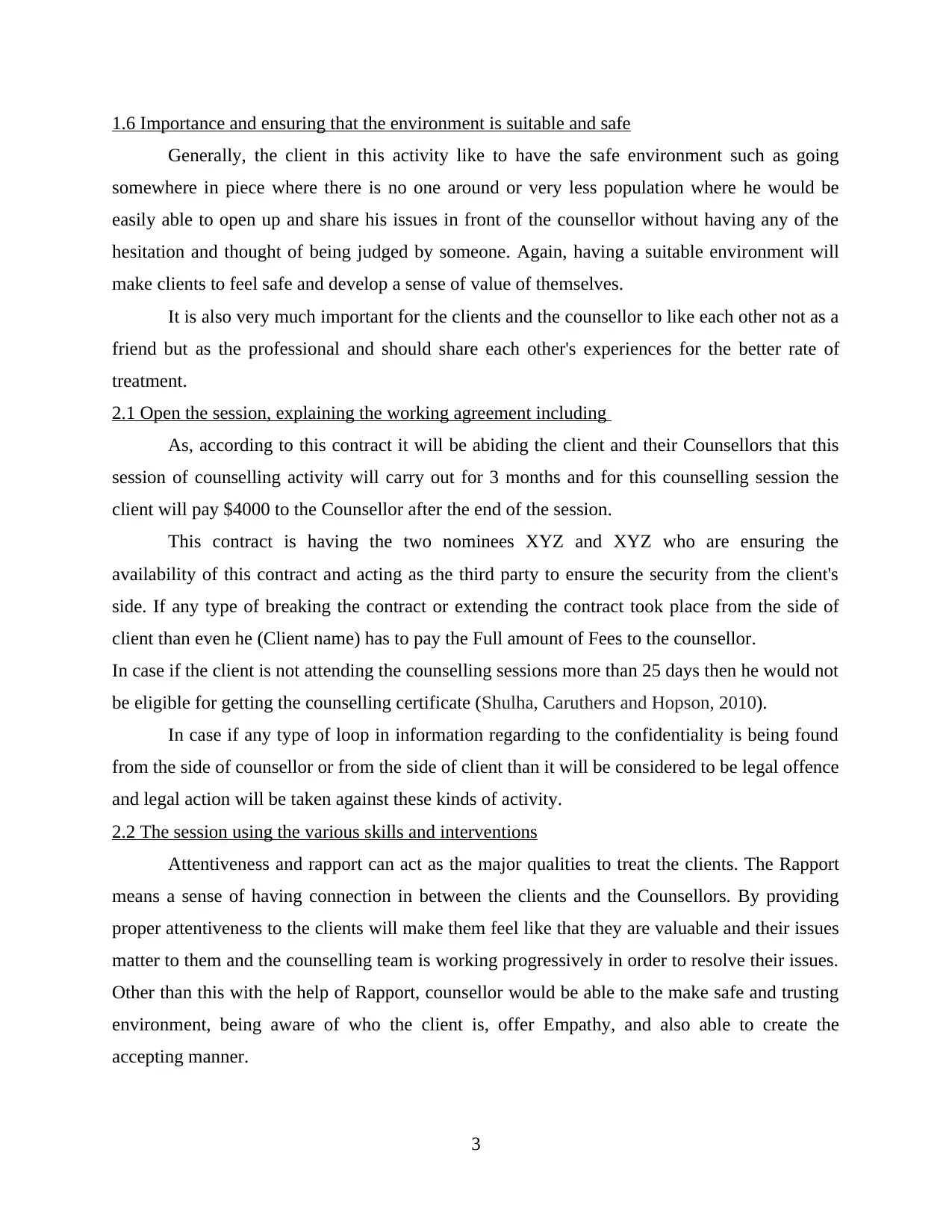
1.6 Importance and ensuring that the environment is suitable and safe
Generally, the client in this activity like to have the safe environment such as going
somewhere in piece where there is no one around or very less population where he would be
easily able to open up and share his issues in front of the counsellor without having any of the
hesitation and thought of being judged by someone. Again, having a suitable environment will
make clients to feel safe and develop a sense of value of themselves.
It is also very much important for the clients and the counsellor to like each other not as a
friend but as the professional and should share each other's experiences for the better rate of
treatment.
2.1 Open the session, explaining the working agreement including
As, according to this contract it will be abiding the client and their Counsellors that this
session of counselling activity will carry out for 3 months and for this counselling session the
client will pay $4000 to the Counsellor after the end of the session.
This contract is having the two nominees XYZ and XYZ who are ensuring the
availability of this contract and acting as the third party to ensure the security from the client's
side. If any type of breaking the contract or extending the contract took place from the side of
client than even he (Client name) has to pay the Full amount of Fees to the counsellor.
In case if the client is not attending the counselling sessions more than 25 days then he would not
be eligible for getting the counselling certificate (Shulha, Caruthers and Hopson, 2010).
In case if any type of loop in information regarding to the confidentiality is being found
from the side of counsellor or from the side of client than it will be considered to be legal offence
and legal action will be taken against these kinds of activity.
2.2 The session using the various skills and interventions
Attentiveness and rapport can act as the major qualities to treat the clients. The Rapport
means a sense of having connection in between the clients and the Counsellors. By providing
proper attentiveness to the clients will make them feel like that they are valuable and their issues
matter to them and the counselling team is working progressively in order to resolve their issues.
Other than this with the help of Rapport, counsellor would be able to the make safe and trusting
environment, being aware of who the client is, offer Empathy, and also able to create the
accepting manner.
3
Generally, the client in this activity like to have the safe environment such as going
somewhere in piece where there is no one around or very less population where he would be
easily able to open up and share his issues in front of the counsellor without having any of the
hesitation and thought of being judged by someone. Again, having a suitable environment will
make clients to feel safe and develop a sense of value of themselves.
It is also very much important for the clients and the counsellor to like each other not as a
friend but as the professional and should share each other's experiences for the better rate of
treatment.
2.1 Open the session, explaining the working agreement including
As, according to this contract it will be abiding the client and their Counsellors that this
session of counselling activity will carry out for 3 months and for this counselling session the
client will pay $4000 to the Counsellor after the end of the session.
This contract is having the two nominees XYZ and XYZ who are ensuring the
availability of this contract and acting as the third party to ensure the security from the client's
side. If any type of breaking the contract or extending the contract took place from the side of
client than even he (Client name) has to pay the Full amount of Fees to the counsellor.
In case if the client is not attending the counselling sessions more than 25 days then he would not
be eligible for getting the counselling certificate (Shulha, Caruthers and Hopson, 2010).
In case if any type of loop in information regarding to the confidentiality is being found
from the side of counsellor or from the side of client than it will be considered to be legal offence
and legal action will be taken against these kinds of activity.
2.2 The session using the various skills and interventions
Attentiveness and rapport can act as the major qualities to treat the clients. The Rapport
means a sense of having connection in between the clients and the Counsellors. By providing
proper attentiveness to the clients will make them feel like that they are valuable and their issues
matter to them and the counselling team is working progressively in order to resolve their issues.
Other than this with the help of Rapport, counsellor would be able to the make safe and trusting
environment, being aware of who the client is, offer Empathy, and also able to create the
accepting manner.
3
⊘ This is a preview!⊘
Do you want full access?
Subscribe today to unlock all pages.

Trusted by 1+ million students worldwide
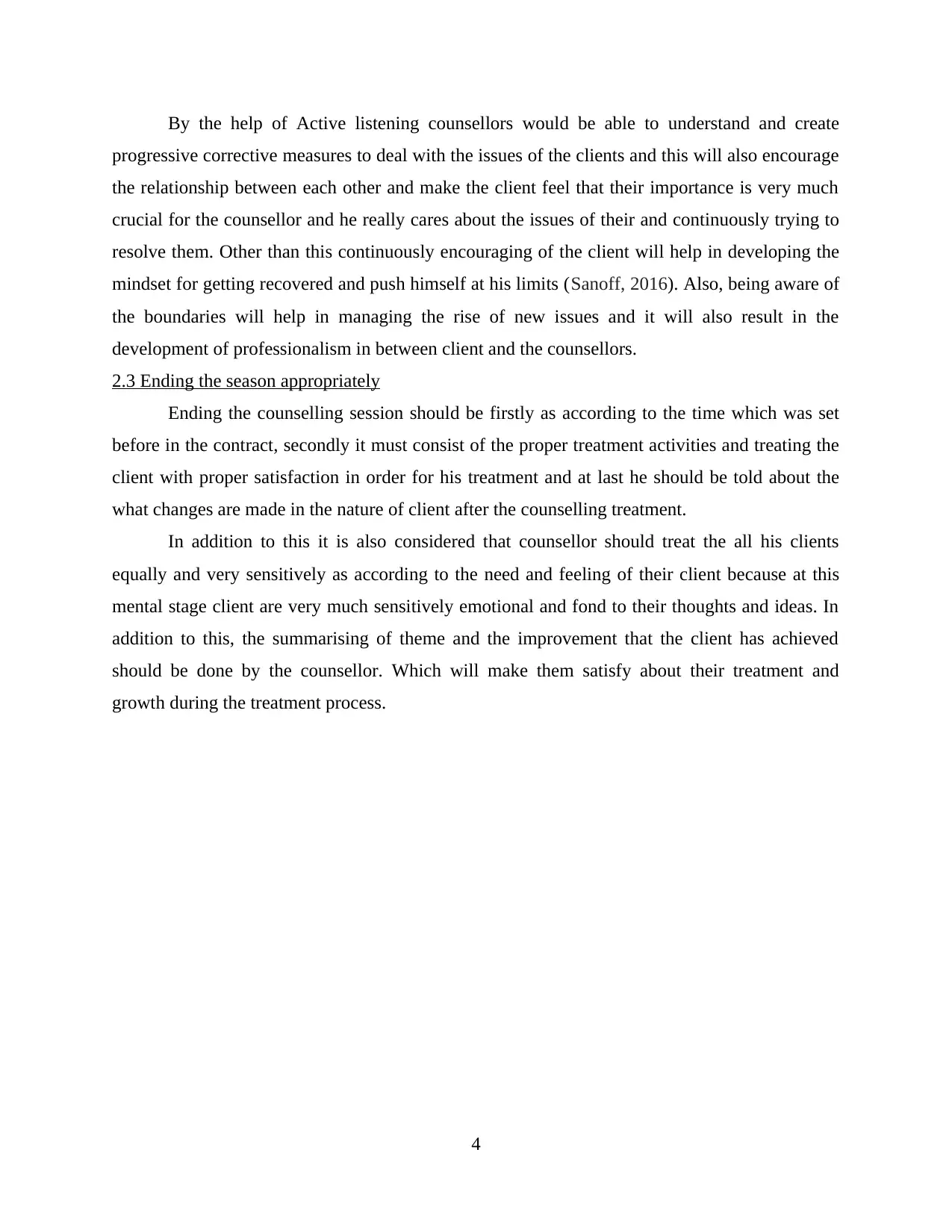
By the help of Active listening counsellors would be able to understand and create
progressive corrective measures to deal with the issues of the clients and this will also encourage
the relationship between each other and make the client feel that their importance is very much
crucial for the counsellor and he really cares about the issues of their and continuously trying to
resolve them. Other than this continuously encouraging of the client will help in developing the
mindset for getting recovered and push himself at his limits (Sanoff, 2016). Also, being aware of
the boundaries will help in managing the rise of new issues and it will also result in the
development of professionalism in between client and the counsellors.
2.3 Ending the season appropriately
Ending the counselling session should be firstly as according to the time which was set
before in the contract, secondly it must consist of the proper treatment activities and treating the
client with proper satisfaction in order for his treatment and at last he should be told about the
what changes are made in the nature of client after the counselling treatment.
In addition to this it is also considered that counsellor should treat the all his clients
equally and very sensitively as according to the need and feeling of their client because at this
mental stage client are very much sensitively emotional and fond to their thoughts and ideas. In
addition to this, the summarising of theme and the improvement that the client has achieved
should be done by the counsellor. Which will make them satisfy about their treatment and
growth during the treatment process.
4
progressive corrective measures to deal with the issues of the clients and this will also encourage
the relationship between each other and make the client feel that their importance is very much
crucial for the counsellor and he really cares about the issues of their and continuously trying to
resolve them. Other than this continuously encouraging of the client will help in developing the
mindset for getting recovered and push himself at his limits (Sanoff, 2016). Also, being aware of
the boundaries will help in managing the rise of new issues and it will also result in the
development of professionalism in between client and the counsellors.
2.3 Ending the season appropriately
Ending the counselling session should be firstly as according to the time which was set
before in the contract, secondly it must consist of the proper treatment activities and treating the
client with proper satisfaction in order for his treatment and at last he should be told about the
what changes are made in the nature of client after the counselling treatment.
In addition to this it is also considered that counsellor should treat the all his clients
equally and very sensitively as according to the need and feeling of their client because at this
mental stage client are very much sensitively emotional and fond to their thoughts and ideas. In
addition to this, the summarising of theme and the improvement that the client has achieved
should be done by the counsellor. Which will make them satisfy about their treatment and
growth during the treatment process.
4
Paraphrase This Document
Need a fresh take? Get an instant paraphrase of this document with our AI Paraphraser
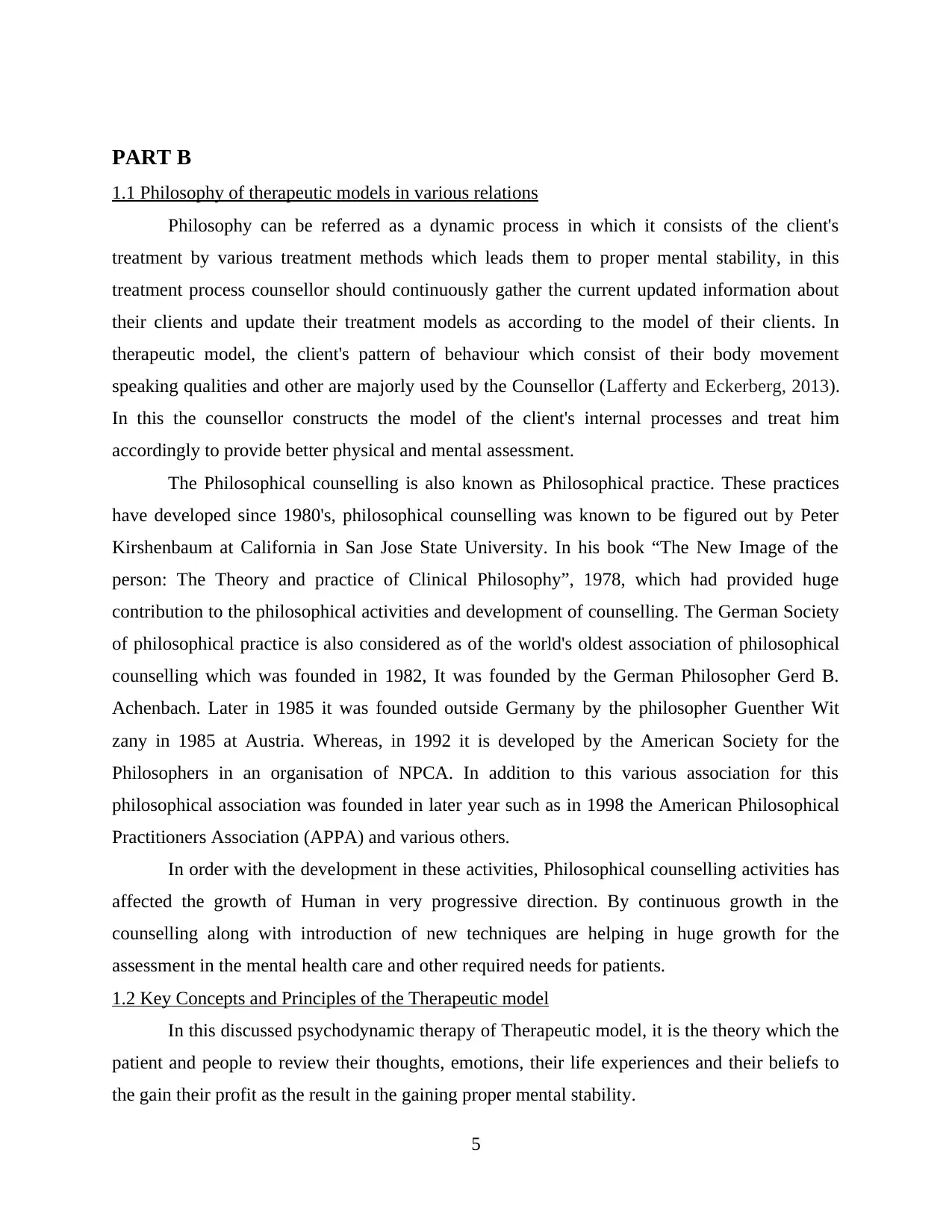
PART B
1.1 Philosophy of therapeutic models in various relations
Philosophy can be referred as a dynamic process in which it consists of the client's
treatment by various treatment methods which leads them to proper mental stability, in this
treatment process counsellor should continuously gather the current updated information about
their clients and update their treatment models as according to the model of their clients. In
therapeutic model, the client's pattern of behaviour which consist of their body movement
speaking qualities and other are majorly used by the Counsellor (Lafferty and Eckerberg, 2013).
In this the counsellor constructs the model of the client's internal processes and treat him
accordingly to provide better physical and mental assessment.
The Philosophical counselling is also known as Philosophical practice. These practices
have developed since 1980's, philosophical counselling was known to be figured out by Peter
Kirshenbaum at California in San Jose State University. In his book “The New Image of the
person: The Theory and practice of Clinical Philosophy”, 1978, which had provided huge
contribution to the philosophical activities and development of counselling. The German Society
of philosophical practice is also considered as of the world's oldest association of philosophical
counselling which was founded in 1982, It was founded by the German Philosopher Gerd B.
Achenbach. Later in 1985 it was founded outside Germany by the philosopher Guenther Wit
zany in 1985 at Austria. Whereas, in 1992 it is developed by the American Society for the
Philosophers in an organisation of NPCA. In addition to this various association for this
philosophical association was founded in later year such as in 1998 the American Philosophical
Practitioners Association (APPA) and various others.
In order with the development in these activities, Philosophical counselling activities has
affected the growth of Human in very progressive direction. By continuous growth in the
counselling along with introduction of new techniques are helping in huge growth for the
assessment in the mental health care and other required needs for patients.
1.2 Key Concepts and Principles of the Therapeutic model
In this discussed psychodynamic therapy of Therapeutic model, it is the theory which the
patient and people to review their thoughts, emotions, their life experiences and their beliefs to
the gain their profit as the result in the gaining proper mental stability.
5
1.1 Philosophy of therapeutic models in various relations
Philosophy can be referred as a dynamic process in which it consists of the client's
treatment by various treatment methods which leads them to proper mental stability, in this
treatment process counsellor should continuously gather the current updated information about
their clients and update their treatment models as according to the model of their clients. In
therapeutic model, the client's pattern of behaviour which consist of their body movement
speaking qualities and other are majorly used by the Counsellor (Lafferty and Eckerberg, 2013).
In this the counsellor constructs the model of the client's internal processes and treat him
accordingly to provide better physical and mental assessment.
The Philosophical counselling is also known as Philosophical practice. These practices
have developed since 1980's, philosophical counselling was known to be figured out by Peter
Kirshenbaum at California in San Jose State University. In his book “The New Image of the
person: The Theory and practice of Clinical Philosophy”, 1978, which had provided huge
contribution to the philosophical activities and development of counselling. The German Society
of philosophical practice is also considered as of the world's oldest association of philosophical
counselling which was founded in 1982, It was founded by the German Philosopher Gerd B.
Achenbach. Later in 1985 it was founded outside Germany by the philosopher Guenther Wit
zany in 1985 at Austria. Whereas, in 1992 it is developed by the American Society for the
Philosophers in an organisation of NPCA. In addition to this various association for this
philosophical association was founded in later year such as in 1998 the American Philosophical
Practitioners Association (APPA) and various others.
In order with the development in these activities, Philosophical counselling activities has
affected the growth of Human in very progressive direction. By continuous growth in the
counselling along with introduction of new techniques are helping in huge growth for the
assessment in the mental health care and other required needs for patients.
1.2 Key Concepts and Principles of the Therapeutic model
In this discussed psychodynamic therapy of Therapeutic model, it is the theory which the
patient and people to review their thoughts, emotions, their life experiences and their beliefs to
the gain their profit as the result in the gaining proper mental stability.
5
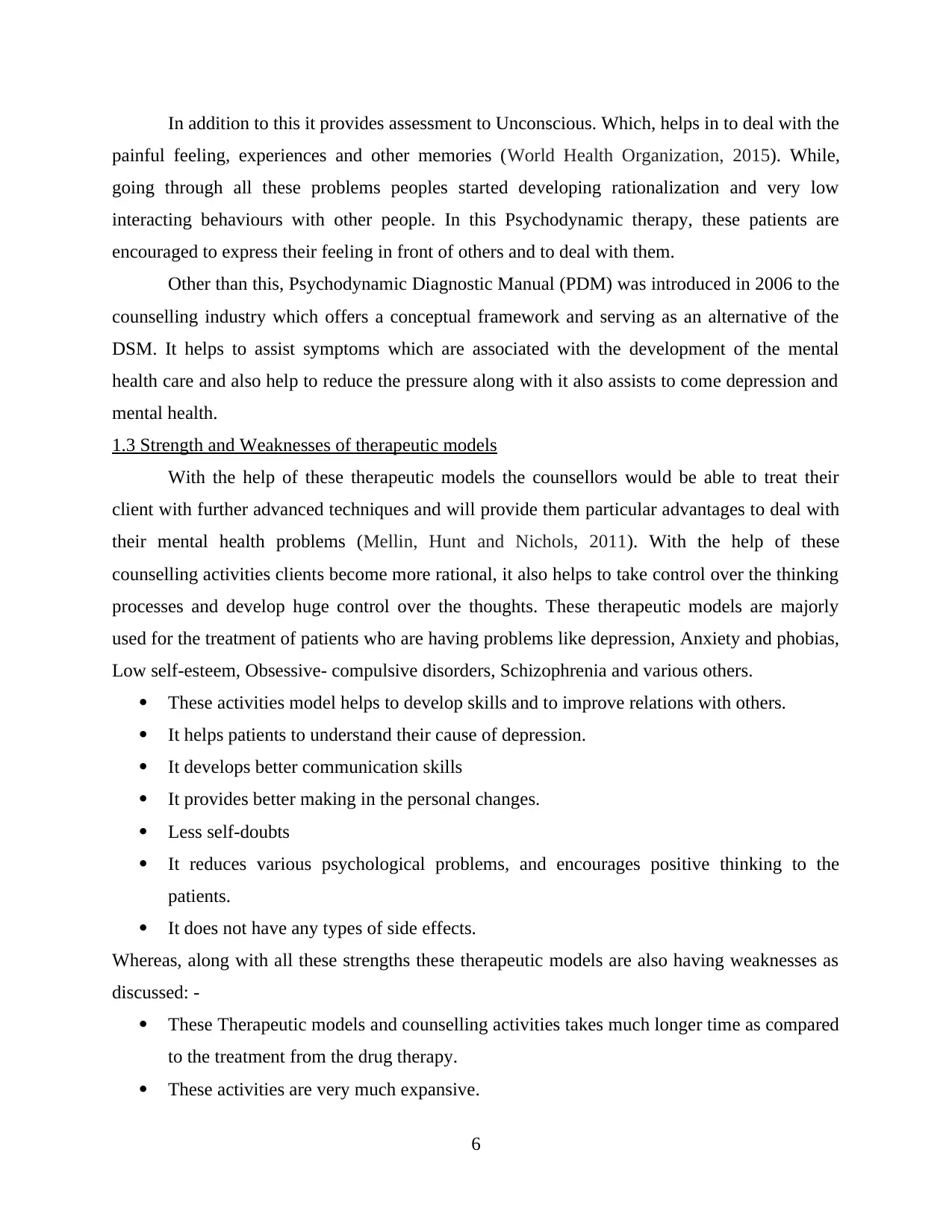
In addition to this it provides assessment to Unconscious. Which, helps in to deal with the
painful feeling, experiences and other memories (World Health Organization, 2015). While,
going through all these problems peoples started developing rationalization and very low
interacting behaviours with other people. In this Psychodynamic therapy, these patients are
encouraged to express their feeling in front of others and to deal with them.
Other than this, Psychodynamic Diagnostic Manual (PDM) was introduced in 2006 to the
counselling industry which offers a conceptual framework and serving as an alternative of the
DSM. It helps to assist symptoms which are associated with the development of the mental
health care and also help to reduce the pressure along with it also assists to come depression and
mental health.
1.3 Strength and Weaknesses of therapeutic models
With the help of these therapeutic models the counsellors would be able to treat their
client with further advanced techniques and will provide them particular advantages to deal with
their mental health problems (Mellin, Hunt and Nichols, 2011). With the help of these
counselling activities clients become more rational, it also helps to take control over the thinking
processes and develop huge control over the thoughts. These therapeutic models are majorly
used for the treatment of patients who are having problems like depression, Anxiety and phobias,
Low self-esteem, Obsessive- compulsive disorders, Schizophrenia and various others.
These activities model helps to develop skills and to improve relations with others.
It helps patients to understand their cause of depression.
It develops better communication skills
It provides better making in the personal changes.
Less self-doubts
It reduces various psychological problems, and encourages positive thinking to the
patients.
It does not have any types of side effects.
Whereas, along with all these strengths these therapeutic models are also having weaknesses as
discussed: -
These Therapeutic models and counselling activities takes much longer time as compared
to the treatment from the drug therapy.
These activities are very much expansive.
6
painful feeling, experiences and other memories (World Health Organization, 2015). While,
going through all these problems peoples started developing rationalization and very low
interacting behaviours with other people. In this Psychodynamic therapy, these patients are
encouraged to express their feeling in front of others and to deal with them.
Other than this, Psychodynamic Diagnostic Manual (PDM) was introduced in 2006 to the
counselling industry which offers a conceptual framework and serving as an alternative of the
DSM. It helps to assist symptoms which are associated with the development of the mental
health care and also help to reduce the pressure along with it also assists to come depression and
mental health.
1.3 Strength and Weaknesses of therapeutic models
With the help of these therapeutic models the counsellors would be able to treat their
client with further advanced techniques and will provide them particular advantages to deal with
their mental health problems (Mellin, Hunt and Nichols, 2011). With the help of these
counselling activities clients become more rational, it also helps to take control over the thinking
processes and develop huge control over the thoughts. These therapeutic models are majorly
used for the treatment of patients who are having problems like depression, Anxiety and phobias,
Low self-esteem, Obsessive- compulsive disorders, Schizophrenia and various others.
These activities model helps to develop skills and to improve relations with others.
It helps patients to understand their cause of depression.
It develops better communication skills
It provides better making in the personal changes.
Less self-doubts
It reduces various psychological problems, and encourages positive thinking to the
patients.
It does not have any types of side effects.
Whereas, along with all these strengths these therapeutic models are also having weaknesses as
discussed: -
These Therapeutic models and counselling activities takes much longer time as compared
to the treatment from the drug therapy.
These activities are very much expansive.
6
⊘ This is a preview!⊘
Do you want full access?
Subscribe today to unlock all pages.

Trusted by 1+ million students worldwide
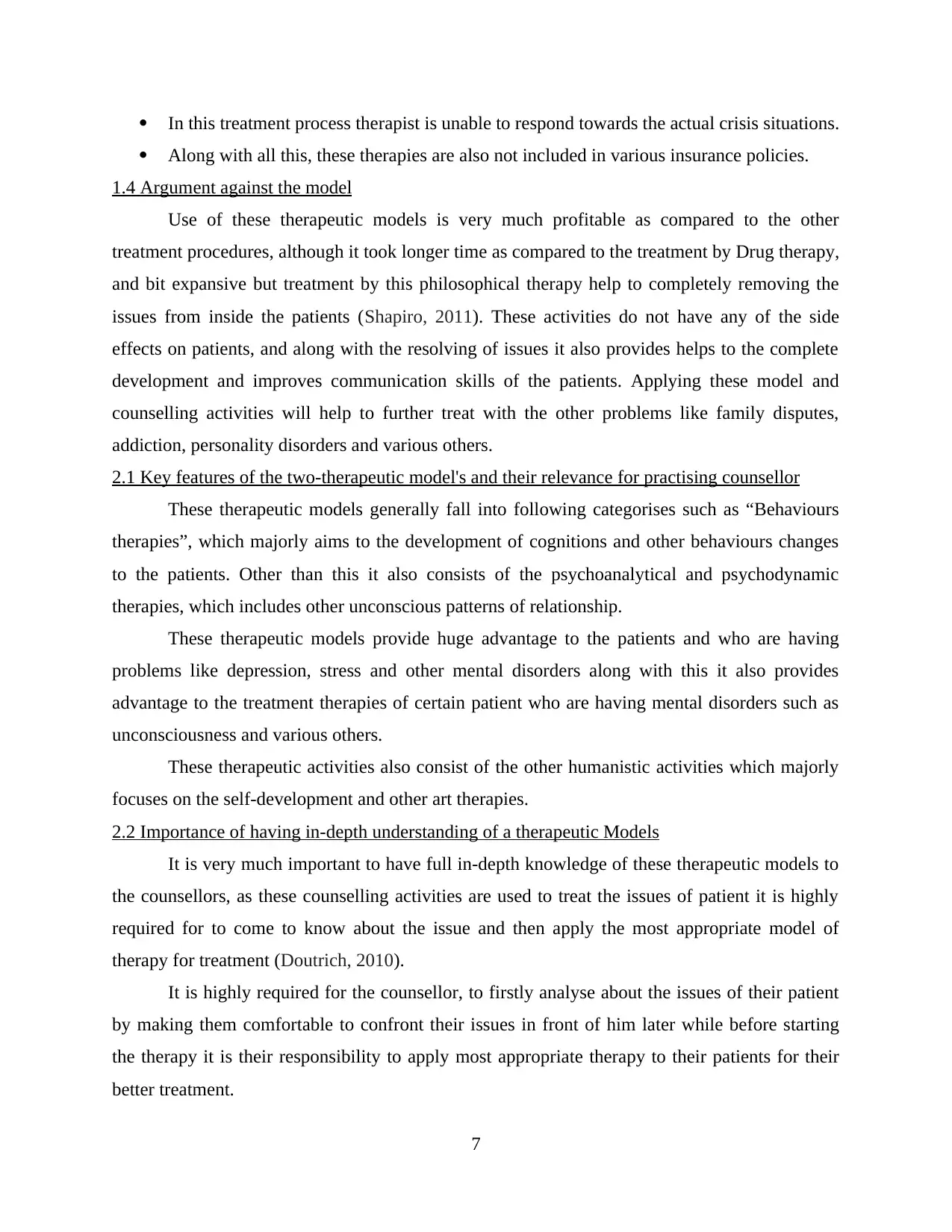
In this treatment process therapist is unable to respond towards the actual crisis situations.
Along with all this, these therapies are also not included in various insurance policies.
1.4 Argument against the model
Use of these therapeutic models is very much profitable as compared to the other
treatment procedures, although it took longer time as compared to the treatment by Drug therapy,
and bit expansive but treatment by this philosophical therapy help to completely removing the
issues from inside the patients (Shapiro, 2011). These activities do not have any of the side
effects on patients, and along with the resolving of issues it also provides helps to the complete
development and improves communication skills of the patients. Applying these model and
counselling activities will help to further treat with the other problems like family disputes,
addiction, personality disorders and various others.
2.1 Key features of the two-therapeutic model's and their relevance for practising counsellor
These therapeutic models generally fall into following categorises such as “Behaviours
therapies”, which majorly aims to the development of cognitions and other behaviours changes
to the patients. Other than this it also consists of the psychoanalytical and psychodynamic
therapies, which includes other unconscious patterns of relationship.
These therapeutic models provide huge advantage to the patients and who are having
problems like depression, stress and other mental disorders along with this it also provides
advantage to the treatment therapies of certain patient who are having mental disorders such as
unconsciousness and various others.
These therapeutic activities also consist of the other humanistic activities which majorly
focuses on the self-development and other art therapies.
2.2 Importance of having in-depth understanding of a therapeutic Models
It is very much important to have full in-depth knowledge of these therapeutic models to
the counsellors, as these counselling activities are used to treat the issues of patient it is highly
required for to come to know about the issue and then apply the most appropriate model of
therapy for treatment (Doutrich, 2010).
It is highly required for the counsellor, to firstly analyse about the issues of their patient
by making them comfortable to confront their issues in front of him later while before starting
the therapy it is their responsibility to apply most appropriate therapy to their patients for their
better treatment.
7
Along with all this, these therapies are also not included in various insurance policies.
1.4 Argument against the model
Use of these therapeutic models is very much profitable as compared to the other
treatment procedures, although it took longer time as compared to the treatment by Drug therapy,
and bit expansive but treatment by this philosophical therapy help to completely removing the
issues from inside the patients (Shapiro, 2011). These activities do not have any of the side
effects on patients, and along with the resolving of issues it also provides helps to the complete
development and improves communication skills of the patients. Applying these model and
counselling activities will help to further treat with the other problems like family disputes,
addiction, personality disorders and various others.
2.1 Key features of the two-therapeutic model's and their relevance for practising counsellor
These therapeutic models generally fall into following categorises such as “Behaviours
therapies”, which majorly aims to the development of cognitions and other behaviours changes
to the patients. Other than this it also consists of the psychoanalytical and psychodynamic
therapies, which includes other unconscious patterns of relationship.
These therapeutic models provide huge advantage to the patients and who are having
problems like depression, stress and other mental disorders along with this it also provides
advantage to the treatment therapies of certain patient who are having mental disorders such as
unconsciousness and various others.
These therapeutic activities also consist of the other humanistic activities which majorly
focuses on the self-development and other art therapies.
2.2 Importance of having in-depth understanding of a therapeutic Models
It is very much important to have full in-depth knowledge of these therapeutic models to
the counsellors, as these counselling activities are used to treat the issues of patient it is highly
required for to come to know about the issue and then apply the most appropriate model of
therapy for treatment (Doutrich, 2010).
It is highly required for the counsellor, to firstly analyse about the issues of their patient
by making them comfortable to confront their issues in front of him later while before starting
the therapy it is their responsibility to apply most appropriate therapy to their patients for their
better treatment.
7
Paraphrase This Document
Need a fresh take? Get an instant paraphrase of this document with our AI Paraphraser
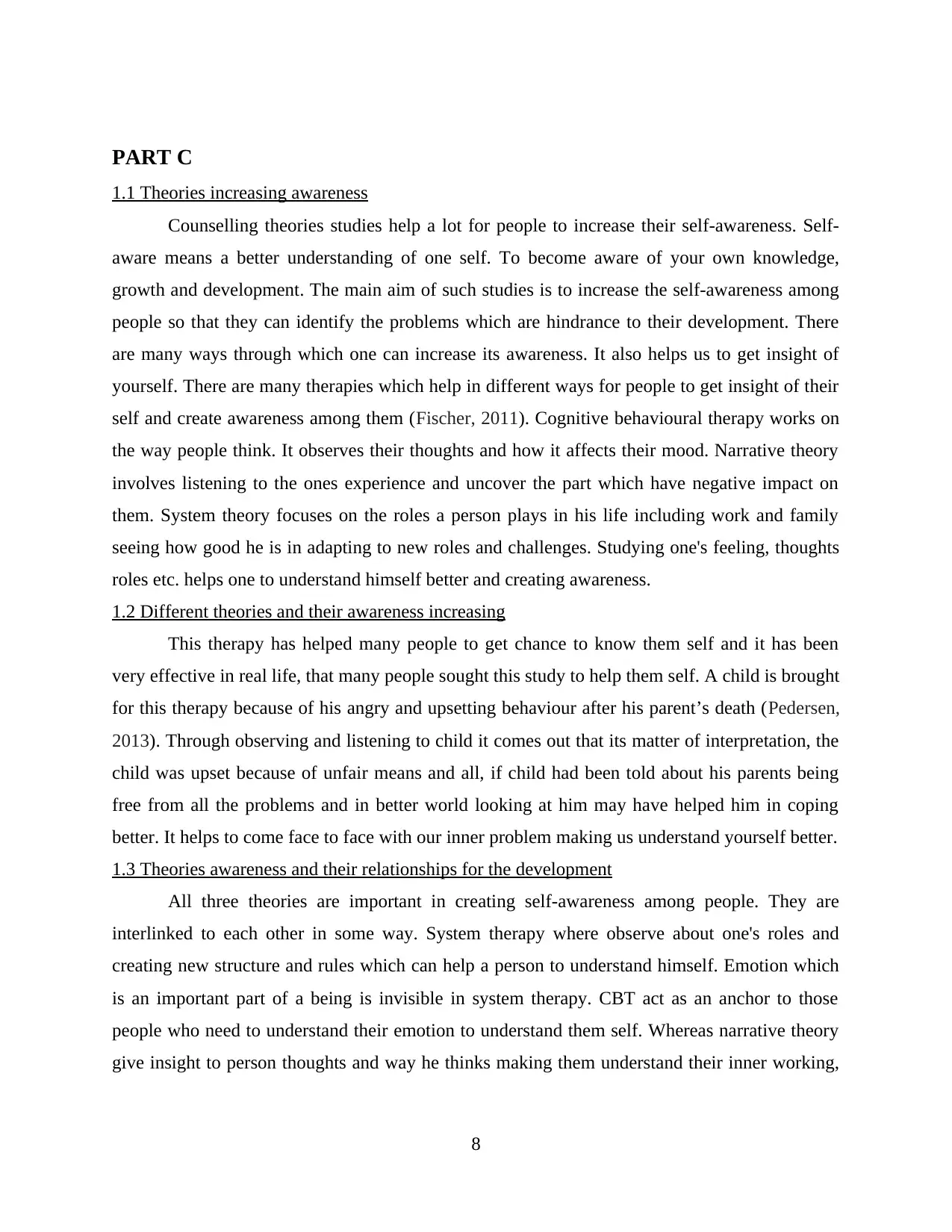
PART C
1.1 Theories increasing awareness
Counselling theories studies help a lot for people to increase their self-awareness. Self-
aware means a better understanding of one self. To become aware of your own knowledge,
growth and development. The main aim of such studies is to increase the self-awareness among
people so that they can identify the problems which are hindrance to their development. There
are many ways through which one can increase its awareness. It also helps us to get insight of
yourself. There are many therapies which help in different ways for people to get insight of their
self and create awareness among them (Fischer, 2011). Cognitive behavioural therapy works on
the way people think. It observes their thoughts and how it affects their mood. Narrative theory
involves listening to the ones experience and uncover the part which have negative impact on
them. System theory focuses on the roles a person plays in his life including work and family
seeing how good he is in adapting to new roles and challenges. Studying one's feeling, thoughts
roles etc. helps one to understand himself better and creating awareness.
1.2 Different theories and their awareness increasing
This therapy has helped many people to get chance to know them self and it has been
very effective in real life, that many people sought this study to help them self. A child is brought
for this therapy because of his angry and upsetting behaviour after his parent’s death (Pedersen,
2013). Through observing and listening to child it comes out that its matter of interpretation, the
child was upset because of unfair means and all, if child had been told about his parents being
free from all the problems and in better world looking at him may have helped him in coping
better. It helps to come face to face with our inner problem making us understand yourself better.
1.3 Theories awareness and their relationships for the development
All three theories are important in creating self-awareness among people. They are
interlinked to each other in some way. System therapy where observe about one's roles and
creating new structure and rules which can help a person to understand himself. Emotion which
is an important part of a being is invisible in system therapy. CBT act as an anchor to those
people who need to understand their emotion to understand them self. Whereas narrative theory
give insight to person thoughts and way he thinks making them understand their inner working,
8
1.1 Theories increasing awareness
Counselling theories studies help a lot for people to increase their self-awareness. Self-
aware means a better understanding of one self. To become aware of your own knowledge,
growth and development. The main aim of such studies is to increase the self-awareness among
people so that they can identify the problems which are hindrance to their development. There
are many ways through which one can increase its awareness. It also helps us to get insight of
yourself. There are many therapies which help in different ways for people to get insight of their
self and create awareness among them (Fischer, 2011). Cognitive behavioural therapy works on
the way people think. It observes their thoughts and how it affects their mood. Narrative theory
involves listening to the ones experience and uncover the part which have negative impact on
them. System theory focuses on the roles a person plays in his life including work and family
seeing how good he is in adapting to new roles and challenges. Studying one's feeling, thoughts
roles etc. helps one to understand himself better and creating awareness.
1.2 Different theories and their awareness increasing
This therapy has helped many people to get chance to know them self and it has been
very effective in real life, that many people sought this study to help them self. A child is brought
for this therapy because of his angry and upsetting behaviour after his parent’s death (Pedersen,
2013). Through observing and listening to child it comes out that its matter of interpretation, the
child was upset because of unfair means and all, if child had been told about his parents being
free from all the problems and in better world looking at him may have helped him in coping
better. It helps to come face to face with our inner problem making us understand yourself better.
1.3 Theories awareness and their relationships for the development
All three theories are important in creating self-awareness among people. They are
interlinked to each other in some way. System therapy where observe about one's roles and
creating new structure and rules which can help a person to understand himself. Emotion which
is an important part of a being is invisible in system therapy. CBT act as an anchor to those
people who need to understand their emotion to understand them self. Whereas narrative theory
give insight to person thoughts and way he thinks making them understand their inner working,
8
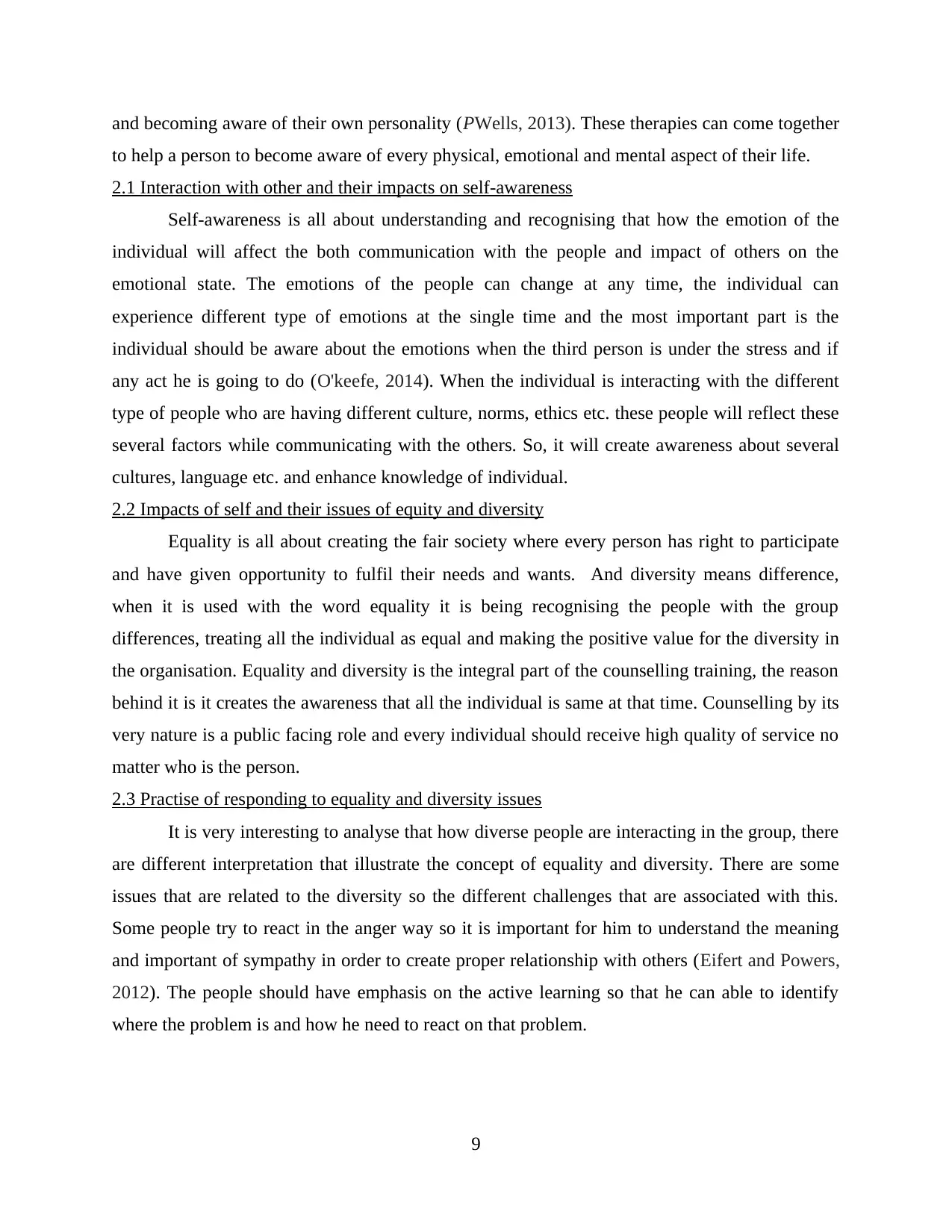
and becoming aware of their own personality (PWells, 2013). These therapies can come together
to help a person to become aware of every physical, emotional and mental aspect of their life.
2.1 Interaction with other and their impacts on self-awareness
Self-awareness is all about understanding and recognising that how the emotion of the
individual will affect the both communication with the people and impact of others on the
emotional state. The emotions of the people can change at any time, the individual can
experience different type of emotions at the single time and the most important part is the
individual should be aware about the emotions when the third person is under the stress and if
any act he is going to do (O'keefe, 2014). When the individual is interacting with the different
type of people who are having different culture, norms, ethics etc. these people will reflect these
several factors while communicating with the others. So, it will create awareness about several
cultures, language etc. and enhance knowledge of individual.
2.2 Impacts of self and their issues of equity and diversity
Equality is all about creating the fair society where every person has right to participate
and have given opportunity to fulfil their needs and wants. And diversity means difference,
when it is used with the word equality it is being recognising the people with the group
differences, treating all the individual as equal and making the positive value for the diversity in
the organisation. Equality and diversity is the integral part of the counselling training, the reason
behind it is it creates the awareness that all the individual is same at that time. Counselling by its
very nature is a public facing role and every individual should receive high quality of service no
matter who is the person.
2.3 Practise of responding to equality and diversity issues
It is very interesting to analyse that how diverse people are interacting in the group, there
are different interpretation that illustrate the concept of equality and diversity. There are some
issues that are related to the diversity so the different challenges that are associated with this.
Some people try to react in the anger way so it is important for him to understand the meaning
and important of sympathy in order to create proper relationship with others (Eifert and Powers,
2012). The people should have emphasis on the active learning so that he can able to identify
where the problem is and how he need to react on that problem.
9
to help a person to become aware of every physical, emotional and mental aspect of their life.
2.1 Interaction with other and their impacts on self-awareness
Self-awareness is all about understanding and recognising that how the emotion of the
individual will affect the both communication with the people and impact of others on the
emotional state. The emotions of the people can change at any time, the individual can
experience different type of emotions at the single time and the most important part is the
individual should be aware about the emotions when the third person is under the stress and if
any act he is going to do (O'keefe, 2014). When the individual is interacting with the different
type of people who are having different culture, norms, ethics etc. these people will reflect these
several factors while communicating with the others. So, it will create awareness about several
cultures, language etc. and enhance knowledge of individual.
2.2 Impacts of self and their issues of equity and diversity
Equality is all about creating the fair society where every person has right to participate
and have given opportunity to fulfil their needs and wants. And diversity means difference,
when it is used with the word equality it is being recognising the people with the group
differences, treating all the individual as equal and making the positive value for the diversity in
the organisation. Equality and diversity is the integral part of the counselling training, the reason
behind it is it creates the awareness that all the individual is same at that time. Counselling by its
very nature is a public facing role and every individual should receive high quality of service no
matter who is the person.
2.3 Practise of responding to equality and diversity issues
It is very interesting to analyse that how diverse people are interacting in the group, there
are different interpretation that illustrate the concept of equality and diversity. There are some
issues that are related to the diversity so the different challenges that are associated with this.
Some people try to react in the anger way so it is important for him to understand the meaning
and important of sympathy in order to create proper relationship with others (Eifert and Powers,
2012). The people should have emphasis on the active learning so that he can able to identify
where the problem is and how he need to react on that problem.
9
⊘ This is a preview!⊘
Do you want full access?
Subscribe today to unlock all pages.

Trusted by 1+ million students worldwide
1 out of 18
Related Documents
Your All-in-One AI-Powered Toolkit for Academic Success.
+13062052269
info@desklib.com
Available 24*7 on WhatsApp / Email
![[object Object]](/_next/static/media/star-bottom.7253800d.svg)
Unlock your academic potential
Copyright © 2020–2025 A2Z Services. All Rights Reserved. Developed and managed by ZUCOL.





